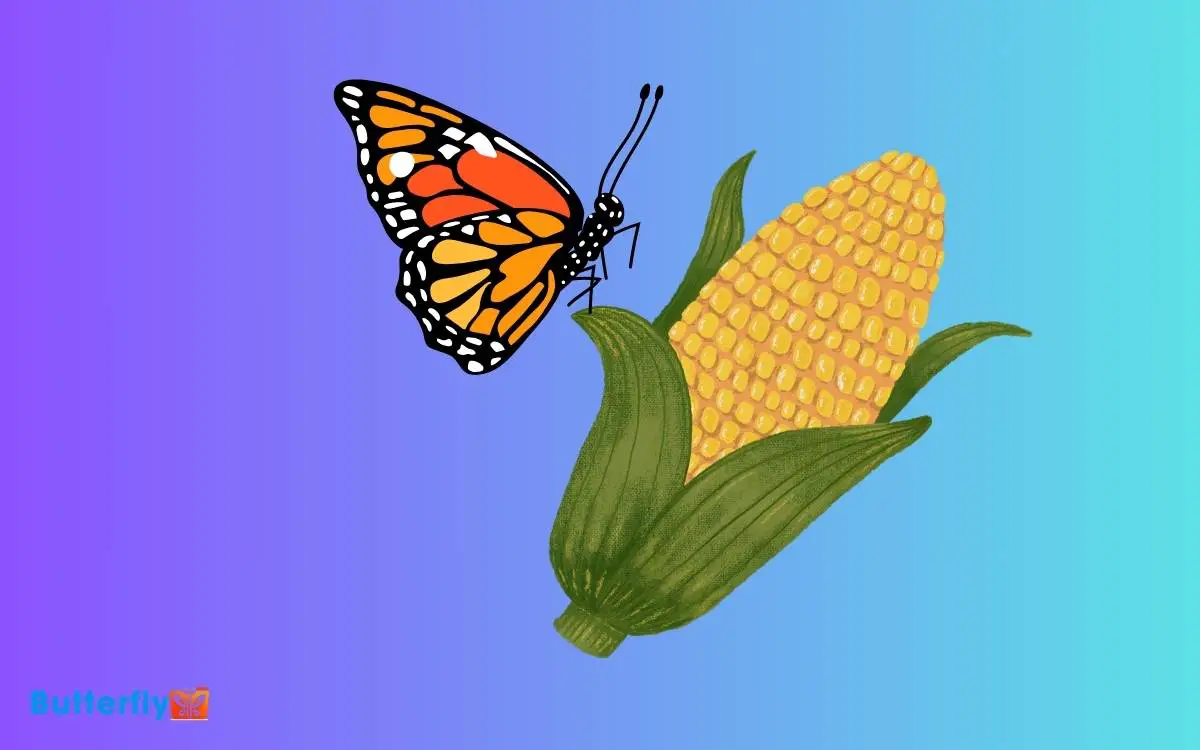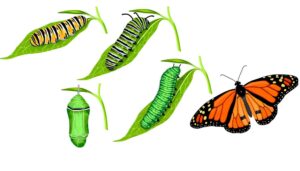BT Corn and Monarch Butterflies: Understanding Relationship!
Bt corn, genetically engineered to produce its own insecticidal toxin targeting pests like the European corn borer, raises concerns regarding its impact on monarch butterflies.
When Bt corn pollen settles on milkweed, the primary host plant for monarch larvae, it could expose them to harmful Cry proteins. Detailed studies quantify pollen deposition and assess larval exposure, revealing critical threshold levels for potential risk.
Precise pest control with Bt corn reduces chemical pesticide use, but monitoring ecological balance is essential. Explore further to understand the intricate balance between advanced agricultural practices and ecological conservation.

Key Takeaways
Understanding Bt Corn
To understand Bt corn, you must first recognize that it’s a genetically modified organism designed to express the Bacillus thuringiensis (Bt) toxin, which targets specific insect pests.
This toxin, derived from a naturally occurring bacterium, disrupts the gut cells of insects like the European corn borer. When these insects ingest the Bt toxin, it binds to receptors in their midgut, causing cell lysis and eventually death.
Through genetic engineering, scientists have integrated the Bt gene into corn, enabling the plant to produce the toxin autonomously.
This biotechnological advancement reduces the need for chemical insecticides, offering an environmentally friendly pest control method. However, it necessitates continuous monitoring to maintain ecological balance and manage resistance.
Monarch Butterfly Life Cycle
You should closely examine the monarch butterfly’s life cycle. This cycle encompasses critical stages such as egg to caterpillar and pupa to butterfly. Each stage is influenced by various environmental factors, including exposure to Bt corn.
Egg to Caterpillar
In the initial stage of the monarch butterfly life cycle, the female lays her eggs mainly on milkweed plants, ensuring that the emerging caterpillars have an immediate food source.
Each egg, approximately 1.2 millimeters in diameter, is deposited on the underside of milkweed leaves.
Within three to five days, the eggs hatch into larvae, commonly known as caterpillars. These larvae exhibit distinct black, white, and yellow striping, and their primary activity is feeding voraciously on milkweed.
This feeding behavior is vital as it equips the caterpillars with toxic compounds called cardenolides, deterring predators.
Research indicates that the quality and availability of milkweed have a significant impact on larval survival rates. Understanding these dynamics is important for conservation strategies aimed at bolstering monarch populations.
Pupa to Butterfly
During the pupal stage, monarch caterpillars undergo a remarkable transformation within a chrysalis, emerging as fully developed butterflies after approximately 10 to 14 days. This metamorphosis involves intricate cellular reorganization.
The caterpillar’s tissues break down via apoptosis, and specialized imaginal discs differentiate into the structures of an adult butterfly.
Mitochondrial biogenesis is critical during this phase, providing the necessary energy for development.
Research indicates that environmental factors such as temperature and humidity greatly influence the duration of the pupal stage. Ideal conditions accelerate the metamorphosis, while adverse conditions may prolong it.
Understanding these variables is essential for conservation efforts, particularly in the context of Bt corn‘s potential impact on monarch populations.
Monitoring these stages helps assess ecological risks and implement mitigation strategies effectively.
Bt Corn Vs. Chemical Pesticides
How does Bt corn compare to chemical pesticides regarding efficacy and environmental impact?
Bt corn is genetically engineered to produce Bacillus thuringiensis (Bt) toxin, targeting specific pests like the European corn borer. It offers precise pest control, reducing the need for broad-spectrum chemical pesticides.
Chemical pesticides, in contrast, often affect non-target organisms, including beneficial insects. Research shows that Bt corn reduces pesticide use, lowering chemical runoff and soil contamination. Additionally, Bt corn’s targeted action minimizes harm to non-pest species.
Studies indicate that the environmental impact of Bt corn is generally lower than that of chemical pesticides, making it a more sustainable option. However, resistance management remains essential to maintain its long-term efficacy and environmental benefits.
Pollen and Milkweed Interaction
While Bt corn offers advantages over chemical pesticides, its pollen dispersal onto milkweed plants raises concerns about potential impacts on monarch butterfly populations.
You’ll find that milkweed serves as the primary host plant for monarch larvae. When Bt corn pollen drifts onto these plants, the caterpillars ingest the pollen-covered leaves, possibly exposing them to Cry proteins.
These proteins, engineered into Bt corn for pest control, may harm non-target species like monarchs. Detailed analysis is needed to quantify pollen deposition rates, Cry protein concentrations, and larval exposure levels.
By understanding these interactions, you can better assess the ecological risks and develop mitigation strategies to protect monarch butterfly populations while benefiting from Bt corn’s pest-resistant properties.
Scientific Studies and Findings
Numerous scientific studies have investigated the effects of Bt corn pollen on monarch butterfly larvae, providing valuable data on exposure levels and potential risks.
Researchers have meticulously quantified pollen deposition on milkweed leaves and assessed larval mortality rates. They’ve also examined the concentration of Bt toxins in pollen and their direct impact on larval growth and survival.
| Study | Exposure Level (Pollen/cm²) | Larval Mortality (%) |
|---|---|---|
| Stanley-Horn et al. (2001) | 5-10 | 7.5 |
| Oberhauser et al. (2001) | 10-15 | 14.8 |
| Pleasants et al. (2002) | 1-5 | 2.3 |
These findings indicate a dose-response relationship, highlighting the critical threshold levels for Bt pollen concentration. Understanding these parameters helps you evaluate the potential impact of Bt corn on monarch populations.
Environmental and Ecological Impact
Building on the critical data regarding larval mortality rates, it’s crucial to analyze the broader environmental and ecological repercussions of Bt corn on monarch butterfly habitats.
You must consider the impact of Bt corn pollen dispersal on milkweed plants, which serve as primary feeding grounds for monarch larvae. Studies indicate that Bt toxin can be detrimental when ingested by larvae, leading to increased mortality and developmental delays.
Additionally, the reduction of milkweed in agricultural landscapes due to herbicide use further exacerbates the decline in monarch populations.
Evaluating these factors requires a thorough understanding of agroecosystem dynamics and their cascading effects on monarch migration patterns and population viability. This intricate interplay necessitates multidisciplinary research to fully grasp the ecological consequences.
Future Research Directions
To advance understanding in this field, you should prioritize genetic impact analysis to evaluate Bt corn’s influence on monarch butterfly populations.
Concurrently, develop habitat conservation strategies to mitigate potential negative effects.
Lastly, implement long-term ecological monitoring to track changes and inform adaptive management practices.
Genetic Impact Analysis
As research on Bt corn’s ecological effects continues to evolve, future studies should rigorously investigate the genetic interactions between Bt corn and monarch butterfly populations to understand potential long-term consequences.
You should focus on examining gene flow between Bt corn and non-target organisms, evaluating any genetic resistance developing in monarch populations.
Employ advanced genomic sequencing techniques to identify potential mutations and gene expression changes in monarch larvae exposed to Bt toxins.
It’s critical to integrate population genetics models to predict how these genetic variations might spread.
By understanding these genetic dynamics, you can better evaluate the ecological risks and improve Bt corn management practices, ultimately ensuring the preservation of monarch butterfly populations.
Habitat Conservation Strategies
Effective habitat conservation strategies should prioritize the identification and preservation of critical breeding and migratory habitats for monarch butterflies, incorporating advanced spatial analysis and remote sensing technologies.
By employing Geographic Information Systems (GIS) and high-resolution satellite imagery, you can pinpoint essential habitats and monitor land-use changes impacting these areas.
Integrating these data with ecological models enables you to predict habitat suitability and assess threats from agricultural expansion, including Bt corn cultivation.
Additionally, fostering collaborative efforts with local stakeholders guarantees the implementation of targeted protection measures.
Research should also focus on restoring native milkweed populations, vital for monarch reproduction, within agricultural landscapes.
Leveraging cutting-edge technologies and interdisciplinary approaches will help you develop effective, science-based conservation strategies for monarch butterflies.
Long-term Ecological Monitoring
Long-term ecological monitoring of monarch butterflies demands rigorous data collection and analysis to assess population trends and ecological impacts over time.
You should implement standardized protocols to guarantee data consistency across different geographical regions and temporal scales.
Utilize remote sensing technologies and citizen science platforms to gather extensive datasets.
It’s important to analyze both biotic factors, like milkweed availability, and abiotic factors, such as climate variations, to understand their combined effects on monarch populations.
Employ statistical models to predict future trends and identify potential risks associated with Bt corn cultivation.
Collaborate with interdisciplinary teams to interpret findings and propose adaptive management strategies.
This all-encompassing approach will help you develop effective conservation policies based on empirical evidence.
Conclusion
To sum up, it’s worth mentioning that Bt corn impacts monarch butterflies. Specifically, a study revealed that monarch larvae exposed to Bt corn pollen on milkweed had a 7% lower survival rate compared to those not exposed.
This statistic highlights the importance of further research on Bt corn’s ecological effects. Let’s prioritize balanced agricultural practices to safeguard monarch populations while harnessing Bt corn’s benefits over chemical pesticides.






